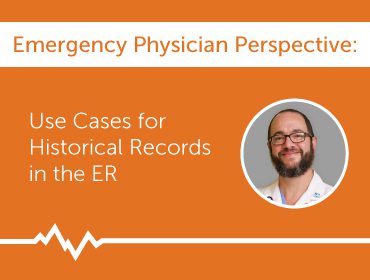
Every patient who enters an emergency room has a story. As an Emergency Physician for the past 20+ years, Dr. Mark Kricheff, MD, MPH, FAAEM needs to know that story, stat.
“Some ER patients aren’t able to provide their own medical history, so access to their records is critical,” explains Dr. Kricheff, who also serves as Chief Clinical Advisor for Harmony Healthcare IT. “Let’s say the patient presents with shortness of breath. We do an X-ray, and see abnormalities, but they might not be conclusive. One X-ray does not tell the whole story; however, add in a prior echocardiogram and that one piece of historical data can make a huge difference to help us differentiate between chronic heart failure vs. covid or pneumonia.”
Bottom Line: One piece of legacy data can dramatically impact current patient care.
In a recent HealthData Talks Podcast, Dr. Kricheff shares several examples of how historical records play an important role in the ER. For example:
- Unresponsive patient – When the patient is unable to communicate their medical history which could stem from being unresponsive, suffering from dementia or with poor healthcare literacy, etc.
- Comparing Imaging/Scans – Longitudinal access to prior CT scans or other DICOM imaging can help the onsite emergency medical team compare current imaging/scans with prior versions to make better informed treatment decisions.
- Provider History – Non-clinical legacy data can be helpful to inform the emergency team of other specialists and medical groups who have provided the patient with care in the past so that referrals for further care are in line with the patient’s medical needs and care providers.
These are just a few examples of how legacy data can be an important asset in the ER. However, there also are scenarios where access to historical information is limited or hard to obtain. This can happen when a health provider changes their EHR to a new system, and the legacy data is left in a data silo which is cumbersome and inefficient to retrieve.
For providers, especially ER departments, who are considering an EHR system replacement, Dr. Kricheff offers some practical advice:
- Do not neglect legacy data access.
- Think about how providers will access historical data.
- Utilize an active archive solution like HealthData Archiver®™ with Single Sign-on capabilities from the new EHR to avoid logging in to multiple legacy applications (e.g., Health Information Exchange, legacy EHR, fax server to retrieve notes from another provider)..
Our team is equipped to assist healthcare providers in emergency rooms and across the enterprise to ensure legacy data does not create an emergency on its own.
Harmony Healthcare IT has been ranked as the top Data Archiving, Data Extraction and Migration company by Black Book™ Rankings, a division of Black Book™ Market Research, for four years in a row. This recognition underscores our commitment to keep patient, employee, and business records accessible, usable, interoperable, secure, and compliant.
For more information on managing legacy patient data in the emergency room or other hospital departments, contact us.






